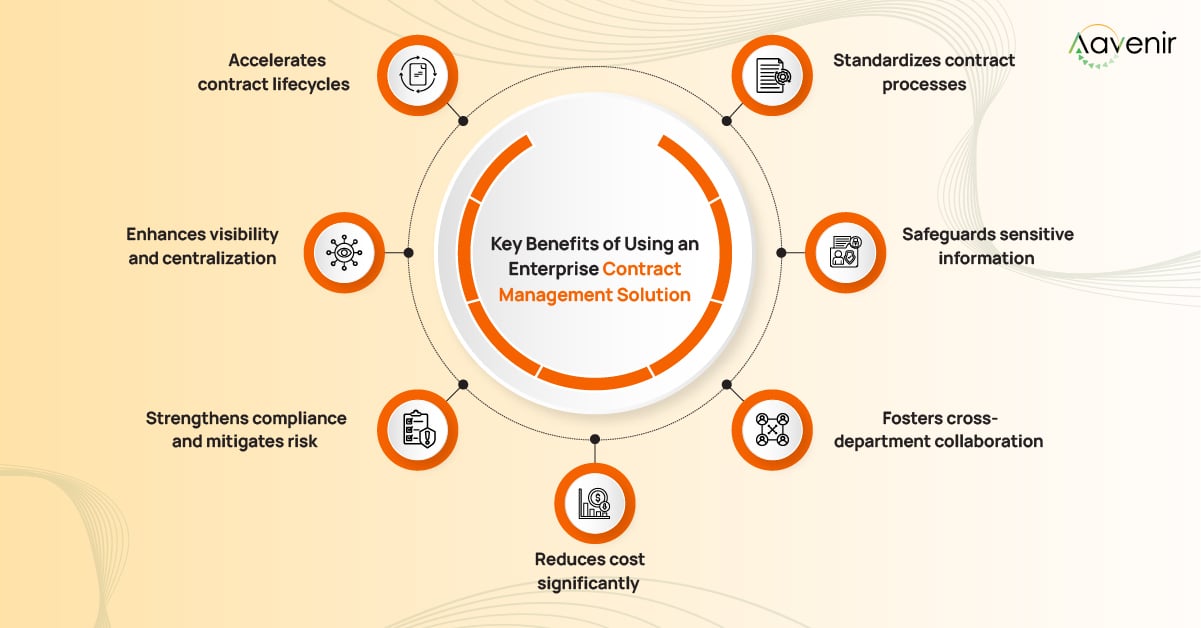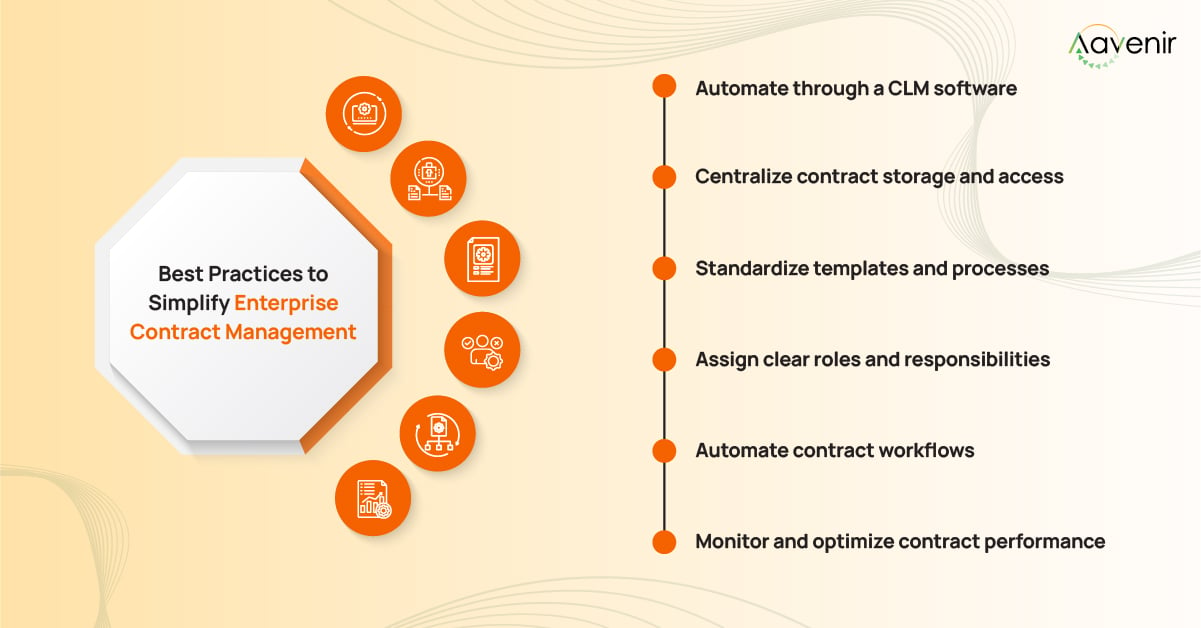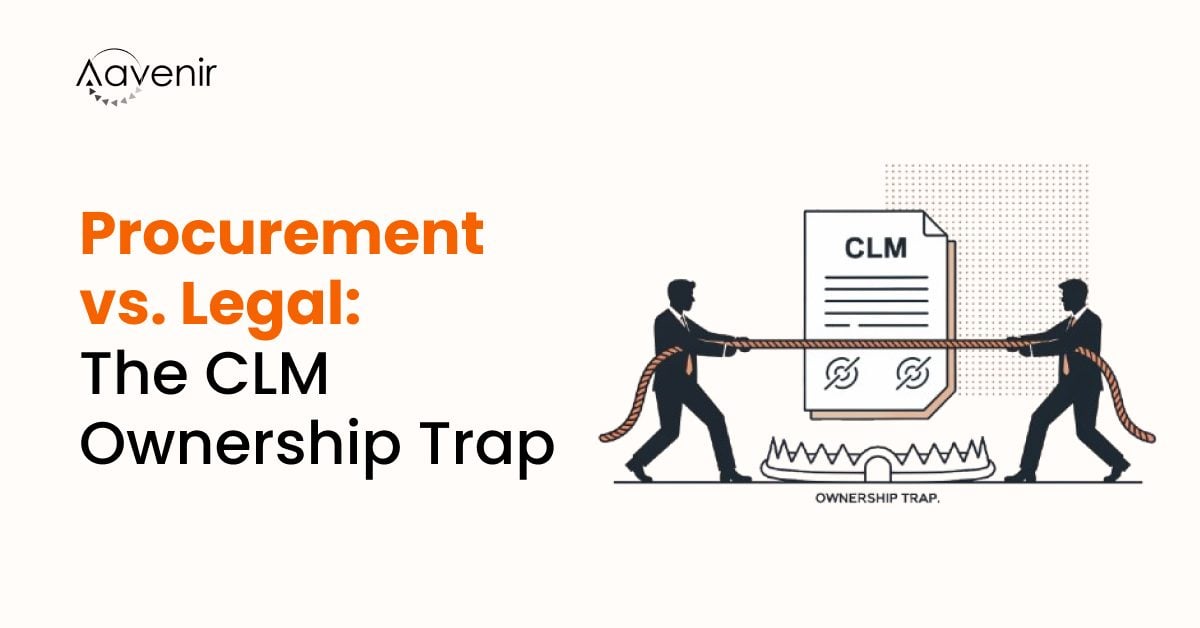Managing contracts at the enterprise level is anything but simple. Contracts are often scattered across departments, buried in email threads, and stored in disconnected systems. Deadlines slip through the cracks, obligations go untracked, and teams waste hours chasing down the latest version of an agreement.
In fact, according to World Commerce & Contracting, poor contract management can cost companies up to 9% of their annual revenue—a significant loss driven by missed obligations, delayed approvals, and compliance failures.
As contract volumes grow and business operations scale, the need for a structured, scalable approach to managing contracts at an enterprise level becomes essential. Without it, enterprises risk non-compliance, missed opportunities, and revenue leakage. This guide will walk you through the essentials of enterprise contract management: what it is, why it matters, common challenges at scale, and how you can overcome them. Whether you’re in legal, procurement, finance, or operations, you’ll find practical insights to bring clarity, control, and consistency to your contracting process. Let’s get started.
What is Enterprise Contract Management?
Enterprise contract management refers to the end-to-end process of managing contracts across large organizations—from creation, review, and negotiation to approval, execution, tracking, and analysis—at scale.
Since enterprises operate on a large scale, they deal with complex compliance requirements, global regulations, and high stakes. Therefore, managing contracts at an enterprise level is different from managing contracts at a small scale.
Often, enterprises use an enterprise contract management solution that helps automate mundane contract lifecycle management tasks and gets more work done through AI-based automation.
Let’s understand how enterprise-level contract management works with an example.
Example: A multinational company manages thousands of contracts with suppliers, customers, and partners across regions. Each contract comes with unique legal terms, compliance needs, and multi-level approvals. Managing this at scale means aligning legal, procurement, finance, and operations—often across time zones.
Here, contract management isn’t just about drafting—it’s about standardizing language, tracking obligations, and staying compliant. A missed renewal or clause can lead to penalties, disputes, or regulatory issues.
At their scale, enterprises deal with complex, high-stakes contracts. Let’s explore different types of contracts managed by enterprises.
Key Contract Types Enterprises Handle
Enterprises manage a wide range of contracts that govern their operations, partnerships, and business relationships. Each contract type serves a specific purpose—whether it’s procuring resources, delivering services, protecting intellectual property, or ensuring regulatory compliance.
Let’s explore the most common contract types enterprises handle on a regular basis.
Procurement Agreements: Govern the acquisition of goods or services, detailing pricing structures, delivery schedules, payment terms, and quality standards.
Sales Contracts: Specify terms for selling products or services, including pricing, delivery expectations, warranty provisions, and payment conditions.
Service Agreements: Define expectations for delivering professional or managed services, covering scope, timelines, fees, and performance obligations.
Supply Contracts: Commit to providing goods or materials over a period of time, often under recurring orders or volume-based commitments.
License Agreements: Grant customers or partners rights to use the enterprise’s intellectual property under defined terms and usage limitations.
Franchise Agreements: Outline the conditions under which third parties can operate using the enterprise’s brand and business model, including fees, operational guidelines, and training requirements.
Loan or Financing Agreements: Detail the terms of borrowing, such as principal amounts, interest rates, repayment schedules, and collateral obligations.
Independent Contractor Agreements: Establish terms for engaging external consultants or freelancers, including project scope, deliverables, timelines, and confidentiality clauses.
Settlement Agreements: Formalize the resolution of disputes through agreed-upon compensation, revised terms, or corrective actions.
Confidentiality Agreements (NDAs): Protect sensitive business information shared with external parties during negotiations, collaborations, or evaluations.
Lease Agreements: Set the terms for leasing office spaces, equipment, or other assets necessary for operational needs.
Enterprises that manage these contracts effectively gain greater visibility, reduce risks, and improve alignment across departments and stakeholders. With the right contract management approach, each agreement becomes a lever for driving measurable business value.
Up next, let’s explore the challenges enterprises face in handling these diverse contract types—and how modern CLM solutions can help.
Key Challenges Enterprises Face in Managing Contracts

Enterprises encounter several challenges in contract management that can hinder efficiency, increase risks, and impact compliance. Below are detailed explanations of these key challenges:
1. Limited Contract Visibility
In large enterprises, contracts are often stored in different systems used by teams like legal, procurement, finance, and even in regional offices. This fragmented storage results in poor visibility of contract status, terms, and renewal timelines.
When stakeholders fail to access updated contract data, it leads to missed obligations, revenue leakage, and lost opportunities. Enterprises need a unified view to monitor contractual performance, enforce terms, and improve cross-functional coordination.
2. Slow Contract Turnaround Times
Lengthy approval chains, manual drafting, and outdated workflows slow down enterprise contract cycles significantly. A single enterprise-level agreement might pass through multiple departments, regions, and legal teams.
Without automation and standardized templates, the issues will be multiplied, resulting in delayed revenue realization, vendor onboarding, and project execution.
3. Compliance and Regulatory Risks
Enterprises working across multiple jurisdictions must comply with a broad spectrum of regulations—GDPR, HIPAA, and industry-specific rules. Here, each contract is scrutinized for jurisdictional compliance and audit readiness.
Manual enterprise contract management exposes enterprises to increased regulatory risks, penalties, and reputational damage. Without extensive compliance checks and thorough audit trails, it becomes difficult to ensure consistent adherence across thousands of contracts.
4. Lack of Standardization
Enterprise-wide consistency in contract language, clauses, and approval workflows is critical but often lacking due to the vast scale of operations. Different business units use different templates, terms, and approval structures, creating confusion, legal exposure, and rework.
This lack of standardization not only slows down negotiations but also increases legal risk and compliance gaps. Establishing standardized clause libraries and organization-wide templates is essential for scalable and secure operations.
5. Volume and Scale
Large organizations manage tens of thousands of contracts annually, from NDAs and MSAs to SOWs and procurement agreements. Tracking every contract’s lifecycle manually becomes challenging as the enterprise grows.
Naturally, enterprises often find it difficult to handle high contract volumes at scale, resulting in missed milestones and inconsistent obligation tracking.
Complex Contract Workflows Slowing Your Enterprise Down?
Streamline contract creation, approvals, and renewals across global teams. Aavenir helps enterprises cut contract cycle times by 80% while staying compliant and in control.
These challenges highlight the difficulties enterprises face when managing contracts. The solution? An intelligent, AI-driven contract lifecycle management platform, such as Aavenir Contractflow. Let’s delve into the key benefits of implementing an enterprise CLM solution in the next section.
7 Key Benefits of Using an Enterprise Contract Management Software

Enterprise contract management software is transforming how businesses handle agreements at scale. Here are the 7 key benefits that enterprise contract management software brings to organizations.
1. Accelerates Contract Lifecycles
Enterprise contract management software accelerates the entire contract lifecycle, starting from initiation to signature. It eliminates delays caused due to manual drafting, fragmented approvals, and email-based negotiations.
With this, teams spend less time chasing faster approvals and more time closing deals, helping the business respond swiftly to new opportunities.
2. Enhances Visibility and Centralization
A centralized enterprise CLM system like Aavenir offers the entire organization comprehensive control over all contracts from a single, searchable repository. With this, the organization can maintain a unified, cloud-based library with contract version history, clause data, and audit trails.
Having such clear visibility comes in handy to stakeholders for tracking contract obligations, compliance monitoring, contract renewals, and retrieving contracts.
3. Strengthens Compliance and Mitigates Risk
CLM software-based risk management helps legal and compliance teams automate compliance tracking, standardize contract approval processes, and track every action. These tools incorporate built-in approval workflows, AI risk detection, automated compliance tracking, and detailed audit trails to prevent unauthorized modifications and minimize legal vulnerabilities.
With the help of these features, legal and procurement teams can more effectively safeguard against regulatory, financial, and reputational risks.
4. Reduces Cost Significantly
Contract management software helps lower the operational costs of enterprises by eliminating inefficiencies. The use of automated tools results in reduced manual workloads, and data-driven insights eliminate missed renewals, overpayments, and financial penalties.
5. Fosters Cross-Department Collaboration
Enterprise contract lifecycle management solutions like Aavenir improve collaboration by connecting legal, sales, procurement, finance, and HR teams on a single platform. Each department can access role-specific views, contribute to the contract creation process, and track real-time status updates and relevant obligations. This results in faster turnaround, fewer errors, and better alignment across departments.
6. Safeguards Sensitive Information
One of the biggest advantages of using an enterprise contract management solution is its ability to protect sensitive contract data. It is capable of implementing encryption, access controls, and role-based permissions to ensure that only authorized users can view or edit documents.
With growing data privacy regulations like GDPR and HIPAA, enterprises rely on CLM systems to stay compliant and prevent data breaches.
7. Standardizes Contract Processes
For large-scale enterprises operating across multiple countries, standardized contract processes are essential for maintaining consistency and legal compliance. CLM software enforces the use of uniform templates, predefined clauses, and automated routing, ensuring that every contract aligns with global company policies and local regulatory standards.
This approach minimizes errors, accelerates negotiations, and strengthens legal enforceability across diverse markets.
These are the benefits of using an enterprise contract management solution. Moving forward, let’s explore five key factors to keep in mind before adopting a new solution.
5 Things to Consider Before Implementing Enterprise Contract Management
Before purchasing an enterprise contract management system, it’s important to step back and evaluate what your organization truly needs—because the wrong solution can create more chaos instead of solving it. Here are 5 factors you should consider when evaluating contract management solutions:
1. Modern Contract Challenges
Before implementing enterprise contract management software, you must conduct a thorough review of all existing contracts. This helps you understand the complexities that you might encounter during migration. Determining the inefficiencies or bottlenecks before implementation helps customize the features of the new system to address specific organizational requirements.
2. System Integration
Another important consideration is to ensure integration capabilities with your existing software platforms, like Enterprise Resource Planning (ERP systems) and Customer Relationship Management (CRM). Additionally, you must assess the ease of data migration to ensure that the new software works well with current technologies.
3. Security and Compliance
When picking an enterprise contract management software, consider security features like encryption, access controls, and data backups. Additionally, you must ensure that the platform is equipped to support internal compliance with industry-specific regulations and internal policies to mitigate potential legal and contractual risks.
4. User Adoption
If you are looking forward to accelerating employee adoption, pick a contract management software with an intuitive user interface. Additionally, evaluate the vendor’s training and support offerings, as effective onboarding and ongoing assistance can significantly reduce the learning curve and help your organization realize benefits more quickly.
5. Cost and ROI
When evaluating contract management software costs, look beyond just the initial licensing fees; consider setup, training, and any anticipated future upgrade expenses as well. Compare these total costs to the projected return on investment, which may include benefits such as time saved, fewer errors, improved compliance, and greater operational efficiency.
Gain Full Visibility into Every Contract, Obligation, and Risk
From legal to procurement, empower every team to move faster. Aavenir’s AI-driven CLM helps you reduce risk, centralize workflows, and manage contracts at scale — up to 5x faster.
Once you’ve assessed the key factors for successful implementation, it’s time to focus on the essential features that define an efficient contract management software solution.
6 Must-Have Features For Enterprise CLM Software
There are various contract management solutions available on the market. However, selecting the right enterprise CLM software can make all the difference in contract efficiency and compliance. Here are 6 key features every organization should look for.
1. Centralized Contract Repository
Enterprises often operate across multiple business units and regions, which leads to contract fragmentation. A centralized contract repository brings all agreements into one secure and searchable location.
This not only ensures version consistency and audit readiness but also gives legal, procurement, and finance teams instant access to the latest documents, enabling faster decision-making at scale.
2. Advanced Workflow Automation
Large enterprises deal with high volumes of contracts involving multiple approvers. Advanced workflow automation routes contracts through predefined approval chains, reducing manual bottlenecks.
By using conditional logic and automating obligation/renewal notifications, enterprises can cut turnaround times, avoid delays, avoid unwanted expirations, and ensure each contract complies with internal protocols before execution.
3. Smart Compliance and Obligation Tracking
Enterprises face significant financial and reputational risks from non-compliance. Smart compliance tracking features provide real-time visibility into key dates, regulatory checkpoints, and contractual commitments.
With automated alerts and compliance dashboards, legal and compliance teams can proactively manage obligations, audit performance, and minimize exposure to fines or litigation.
4. Role-Based Access Control
In an enterprise setting, protecting sensitive contract data is crucial. Role-based access ensures that only designated users, based on department, function, or hierarchy, can view or edit contract details.
This feature not only strengthens data security and meets enterprise IT governance standards but also supports accountability with audit trails and usage logs.
5. Clause Library and Contract Templates
Standardization is key for managing legal risk across thousands of contracts. A centralized clause library and pre-approved templates ensure that all departments use consistent language and comply with organizational policies.
This reduces negotiation cycles, minimizes legal review times, and accelerates contract generation, which is especially critical for enterprises with global operations.
6. AI Review and summarization
For enterprises handling complex contracts at scale, manual reviews are inefficient and error-prone. AI-powered review tools accelerate due diligence by automatically identifying risky clauses and deviations from standard terms and summarizing key contract data.
This enables legal and procurement teams to make informed decisions faster while maintaining control over contractual risks.
Now that you know what features to look for, here are some practical best practices to help you get the most out of your enterprise contract management.
5 Best Practices for Enterprises to Manage Contracts

One of the best ways to manage contracts effectively is to implement best practices that streamline contract management processes, ensure compliance, and mitigate risks. Below are the 5 best practices to manage your contracts effectively.
1. Automate through a CLM software
Opt for Contract Lifecycle Management (CLM) to automate various stages of contract management, like creation, negotiation, approval, and renewal. These platforms accelerate contract cycles, reduce manual errors, and offer real-time insights into contract status.
For example, Aavenir Contractflow offers automated contract generation, real-time collaboration tools, and intelligent workflow automation, which can significantly boost efficiency and help reduce contract turnaround times.
2. Centralize Contract Storage and Access
Establish a centralized, secure, and searchable repository for all contracts and ensure that documents are easily accessible and organized. Opting for centralized storage results in enhanced accessibility and simplified compliance audits. Pick CLM platforms that offer secure storage solutions with advanced search capabilities, version control, and audit trails.
3. Standardize Templates and Processes
Always create and maintain a library of standardized contract templates that comprise pre-approved clauses and terms. It ensures consistency, reduces drafting time, and minimizes legal and financial risks.
Additionally, standardization ensures a streamlined process for contract creation, review, and approval. You must keep updating these templates regularly to maintain compliance with the latest regulations and relevance with current business objectives.
4. Assign Clear Roles and Responsibilities
Ensure to mention the roles and responsibilities of all the stakeholders involved in the contract lifecycle to ensure accountability and efficient collaboration. You can implement role-based access controls in the contract management software to restrict access to sensitive contract information based on user roles, enhancing security and compliance.
5. Automate Contract Workflows
Use automated workflows for contract creation, review, approval, and renewal processes. It reduces the manual intervention, accelerates cycle times, and improves efficiency. CLM platforms like Aavenir provide drag-and-drop workflow builders to design contract processes, automate reminders, and track progress, ensuring that contracts move smoothly through each stage.
6. Monitor and Optimize Contract Performance
Monitor the key performance indicators (KPIs) such as contract cycle time, compliance rates, and value realization. It allows organizations to assess how effective the contract management practices are and identify areas for improvement.
Make use of the reporting and analytics capabilities of CLM platforms to track performance metrics, conduct audits, and optimize contract performance through renegotiations or amendments as necessary.
Simplify Complex Workflows. Centralize Enterprise Contracting.
Enable secure collaboration while managing user roles and permissions effectively with Aavenir’s enterprise-level capabilities.
Scale Smarter with Aavenir’s Enterprise-Grade CLM
Aavenir Contractflow is purpose-built for enterprises looking to manage high volumes of complex contracts with speed, control, and visibility. It’s more than just a tool—it’s a strategic enabler that helps organizations scale operations while minimizing risk and maintaining compliance.
Enterprises using Aavenir have reported:
- Up to 5x faster visibility into contract data
- 80% reduction in contract cycle times
- Significant improvements in risk mitigation, SLA performance, and cost savings
By centralizing contract workflows and automating key stages of the lifecycle, Aavenir turns contract management into a growth driver, not a bottleneck.
Want to see how Aavenir Contractflow can streamline contract operations at scale? Book a demo with our team today.
Frequently Asked Questions on Enterprise Contract Management
1. How does effective enterprise contract management reduce revenue leakage?
Effective enterprise contract management helps organizations reduce revenue leakage by helping them stay on top of key terms like billing dates, price changes, and penalties. With clear tracking and alerts, you avoid missed payments, underbilling, or lost revenue, especially when managing thousands of contracts across teams.
2. How does enterprise contract management differ from regular contract management?
Regular contract management usually involves handling a smaller number of contracts—often manually—for specific departments or teams. It works fine for small businesses with limited contract volume.
Enterprise contract management, on the other hand, is built for large organizations that manage thousands of contracts across departments like legal, procurement, finance, and sales. It requires a more structured approach with automation, standardized templates, approval workflows, and tools to track compliance and risks.
3. Can enterprise contract management systems integrate with other business tools?
Yes, several enterprise contract management systems seamlessly integrate with tools like Salesforce, SAP, and Microsoft 365. This facilitates effortless data flow and process automation across platforms.
4. What are the benefits of effectively managing contracts for an enterprise?
Managing contracts effectively enhances operational efficiency, reduces legal and financial risks, and ensures compliance with regulatory standards. Additionally, it boosts collaboration among various departments, resulting in improved decision-making and optimized business performance.



